The iPhone 6 Review
by Joshua Ho, Brandon Chester, Chris Heinonen & Ryan Smith on September 30, 2014 8:01 AM EST- Posted in
- Smartphones
- Apple
- Mobile
- iPhone 6
Camera
In order to really understand the camera of the iPhone 6, we have to first talk about the components that make up the camera system. While we don’t know the exact model number of either the iPhone 5s or iPhone 6 sensors, we do know that both the front and rear cameras are made by Sony. For the most part, it seems that the optical system is largely unchanged from the iPhone 5s to iPhone 6. The focal length and aperture are identical, and both have five plastic lenses. On the sensor side there are some obvious differences such as the addition of phase detection pixels. However, it’s otherwise difficult to say if anything else has changed in this area. There’s also a new ISP on the SoC, which serves to enable features like 240FPS slow motion video.
Based on what we know about the camera, the one highlight feature seems to be PDAF. While we’ve seen it before in phones like the Galaxy S5, we’ve never really talked about how it works. In short, microlenses on the sensor refract incoming light onto the AF detector in pairs, as seen in the photo below. Once this is done, the image produced by each AF sensor is compared for similarities. By finding these similarities, the ISP can know whether the lens is focused at a point short, long, or on the intended subject and command lens movement to focus on the intended subject. In case 1 in the photo, we see a situation where the camera is focused short, so the lens must move in order to properly focus on the subject, which is case 2. Case 3 and 4 show increasingly extreme cases of focusing too far to focus on the subject.
Source: Wikipedia
The real question is how it works. While we don't have an ideal test for auto focus and capture latency, we can at least get an idea for best case latency by looking at latency for both cases when viewing a well lit ISO chart, which has extremely high contrast and strong lighting so PDAF should be able to operate.

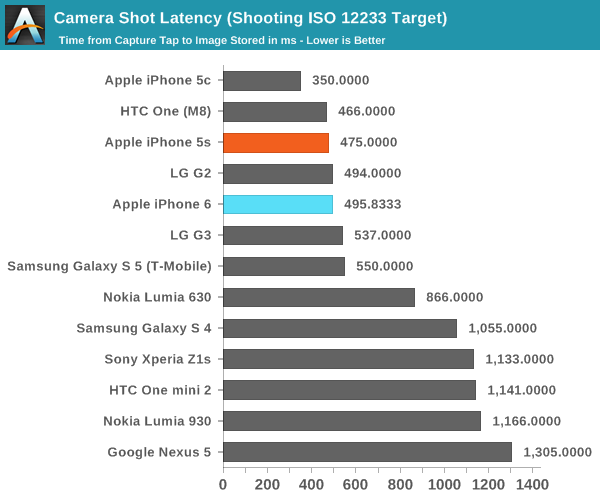
As you can see, it seems that capture latency is mostly unchanged when comparing the two phones but focus latency is dramatically improved in the best case, which is around 200 milliseconds. While the Galaxy S5 does have PDAF, in my experience it was hard to tell if it was any faster than a mostly contrast-based solution like the One M8. With the iPhone 6 the use of PDAF is immediately obvious because in well lit conditions the camera always snaps to focus without ever waiting for the ISP to detect an out of focus condition and run an AF scan. Oddly enough, in all of the manual camera applications that I've tried none of them seem to be able to use continuous auto focus in the preview, which suggests that this isn't exposed in the camera API.
On the UI side, the new camera application isn't a significant departure from what we're used to in iOS but there is one odd UI inconsistency present in the new UI, as in the slow motion video mode tapping the fps option will toggle between 120 and 240 fps but the same isn't true of 1080p60 video, which has to be toggled through the settings application instead of within the camera application.
Otherwise, I'm generally happy with the camera, especially with the new exposure biasing mode which does away with the need to try and get a specific exposure by locking exposure and reframing to get the right photo. While this certainly isn't a new feature the ease of use makes for a better implementation than most. Generally, exposure biasing is hidden in the settings menu so it's a setting that is only selected once and never again. However, Apple's solution will always default to 0 EV and allow for biasing by swiping up to increase exposure and down to reduce it, which means that this solution is fast and easy to do when taking a photo.
Overall, I don't have significant complaints with the camera UI or the general shooting experience. While I'm still looking for an ideal manual camera application I find Apple's mostly all auto solution to be more than sufficient. Of course, the shooting experience alone isn't enough to evaluate a camera so we'll look at image quality next.
Still Image Performance
While I'm still not quite happy with the state of our camera testing procedures, our current tests can generally give a good relative comparison, so the data we're looking at can still be used to draw some conclusions about the camera being tested. One of the first tests that we'll look at is the ISO chart, which uses increasingly tight line spacing to determine what the maximum resolution of the camera is.
In this test, the iPhone 6 does reasonably well, showing low aliasing until around the 16 or 17 mark, which seems to be about the same as the iPhone 5s. In general, this is one area where the iPhone falls short of the competition, which generally tends towards 1.1 micron pixels and sensor sizes larger than a third of an inch. However, it's definitely a great more detail than what we see on the four megapixel sensor of the One (M7) or One (M8). Given the sensor size constraints that Apple seems to be working with this is a respectable showing.
The next scene we'll look at is a daytime landscape shot. For the most part the iPhone 6 does admirably, as noise is well suppressed without noticeable oil painting effects that arise from when noise suppression is too strong and blurs out detail. Dynamic range is also generally quite good as shadowed areas have noticeable detail in this scene. In comparison to the iPhone 5s, while it's relatively hard to see any real differences in detail the noise in areas like the sky and in shadows are noticeably reduced without an obvious decrease in detail.
Following along the lines of the landscape shot, I also set up a lightbox scene with a few objects of varying contrasting textures, text, and feature size to get a good idea of what the limitations of the camera are. In this test scene, we actually see some level of improvement in detail when comparing the iPhone 5s to the iPhone 6. This is most obvious when looking closely at the texture of the metal bell. When compared to the Galaxy S5 LTE-A the iPhone 6 does fall behind a bit due to lower resolution and a mildly wider field of view.
For the next scene, I used the light box and standardized dim lighting in order to provide an example of camera performance between extremely bright and dark scenes. Here, it's relatively difficult to see a difference between the various phones, although with some cameras we're already starting to see a significant amount of detail blurred away in areas like the bell which has a great deal of low contrast detail. There's not too much difference here when comparing the iPhone 6 and 5s, although the 6 does have noticeably lower contrast in these situations.
At the extremes of low light photos, we definitely see a notable improvement in the iPhone 6, which can be attributed to the lower ISO. However, for better or worse we don't see a significant difference in exposure which suggests that this sensor likely has improved sensitivity despite identical pixel size. While we have no way of knowing the exact sensor, it's logical to conclude that the iPhone 6 is using a CMOS sensor process similar to the IMX240 in the GS5 LTE-A at a larger pixel pitch for better sensitivity. What's really incredible about this test photo is that the iPhone 6 manages to deliver an output close to what we see in the iPhone 6 Plus at four times the ISO/sensor gain.
The next two test cases are less about the camera itself and more about how well the OEM has integrated software and hardware. The first test we'll go over is the LED flash test in the lightbox scene that was previously used. While LED flash is generally a rather poor solution for low light photos, it's still important to test as there are some situations where it's absolutely necessary. In this case, Apple has done a great job of selecting an appropriate brightness level to evenly illuminate the scene and provided enough light to keep noise to a minimum, but for some reason there's a pink/red tint to the entire scene. This is one area where the iPhone 5s seems to provide more even color rendering as there is no such tint.
In the HDR test, there's a noticeable improvement in detail and dynamic range from the iPhone 5s to the iPhone 6. Key areas of note include the Media Link HD box, which has noticeably clearer text and there's also significantly more detail on the bell. Judging by the general improvements to detail in closer shots, it may be that these effects are either too subtle to see in landscapes or simply smudged away by noise reduction. There's relatively little to criticize here, as Apple seems to be effectively merging multiple exposures without obvious halos or similar effects that make HDR almost impossible to use in most circumstances.
Overall, the iPhone 6's camera represents a solid improvement over the previous generation, with less noise, more detail in some circumstances, better HDR, and improved low light performance. While it isn't a huge leap ahead, it's definitely more than one might expect. The improvements are subtle though, as there are no fundamental changes to the optics or sensor.








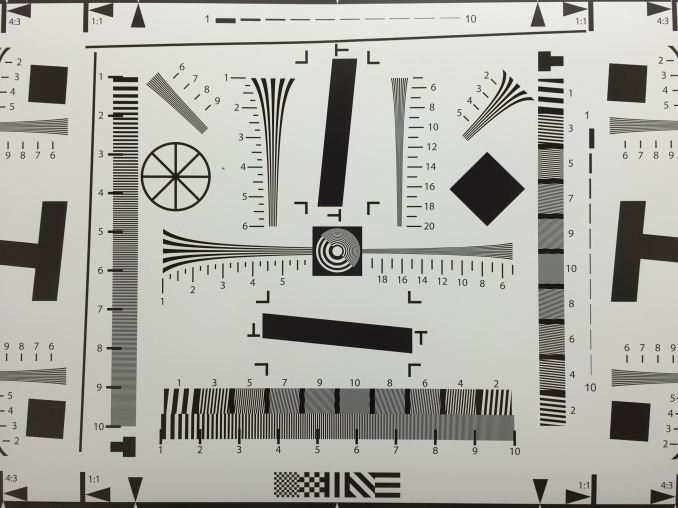






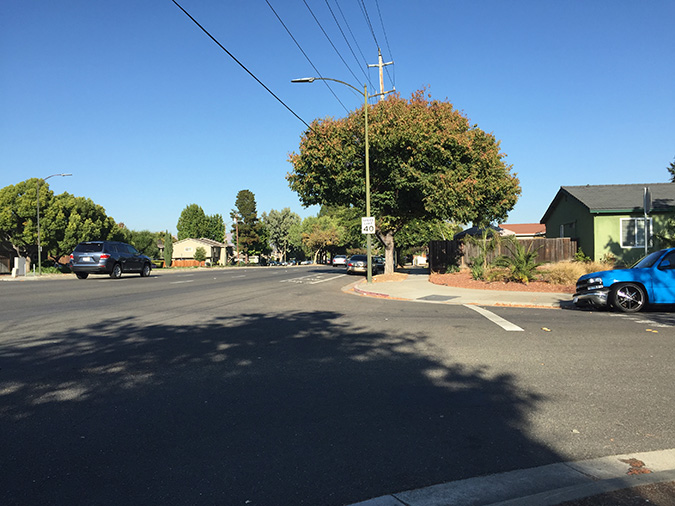






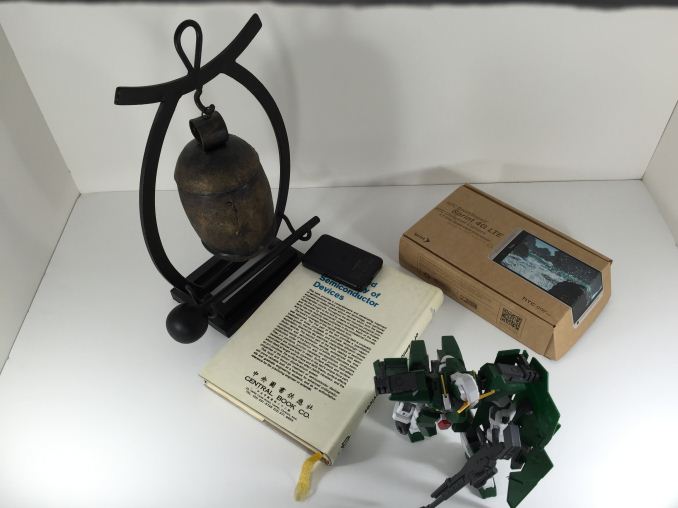






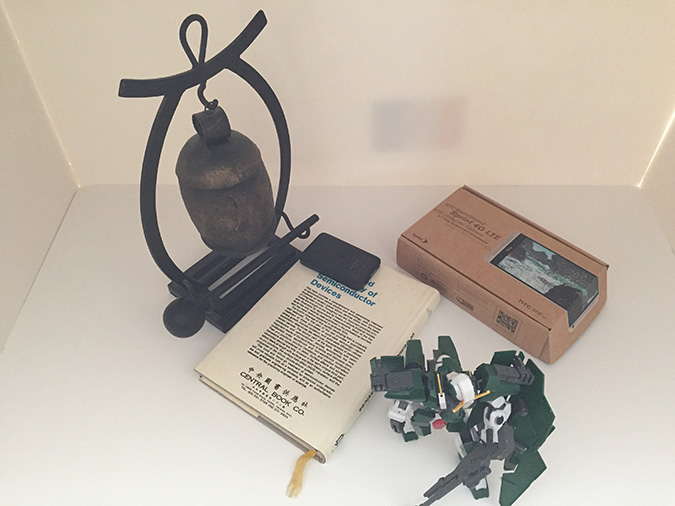






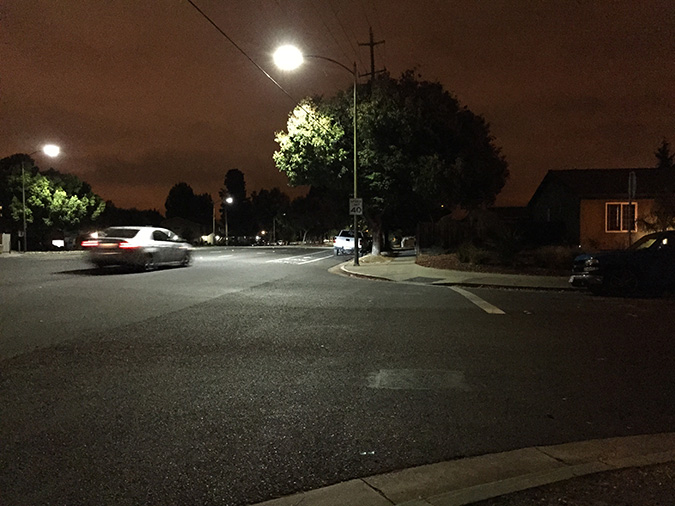









_thumb.jpg)



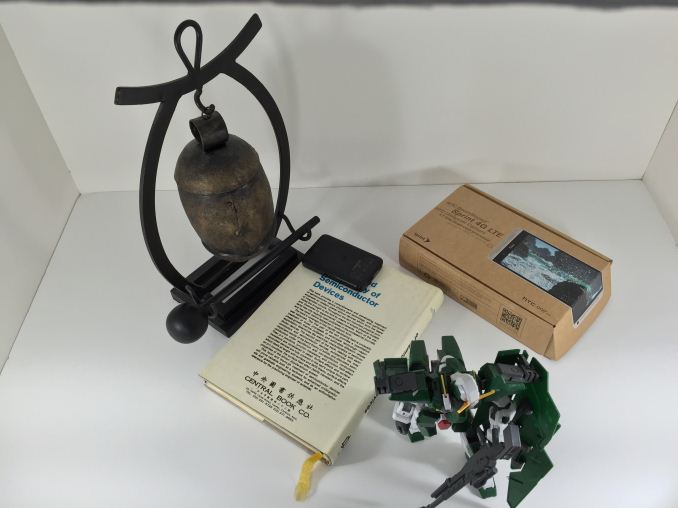








531 Comments
View All Comments
Oxford Guy - Saturday, October 4, 2014 - link
"With Cyclone Apple hit on a very solid design: use a wide, high-IPC design with great latency in order to reach high performance levels at low clock speeds. By keeping the CPU wide and the clock speed low, Apple was able to hit their performance goals without having to push the envelope on power consumption, as lower clock speeds help keep CPU power use in check. It’s all very Intel Core-like, all things considered."The G4 and G5 processors were wide when Intel was doing its lame NetBurst thing. The "wide and shallow" G4 in particular had low clock speeds. The "wide and deep" G5 bumped them up a bit. The "narrow and deep" NetBurst was the high clock speed awful performance per watt Intel brainchild.
Coup27 - Saturday, October 4, 2014 - link
"Fortunately, based on the USB device information for the phones, both the iPhone 6 and 6 Plus support charging with power adapters like the iPad charging block that can provide up to 2.1 amps at five volts. Using one of these chargers will dramatically reduce charge time on the new iPhones, and it's a very worthwhile investment (assuming you don't already have an iPad) for the iPhone 6 Plus in particular."If this was any other phone manufacturer they would have been lambasted for taking the cheaper route and not providing a charger which charges the battery in the most optimal time. However, with this being Apple and all, it's perfectly acceptable to ship a 1A charger and it's a "worthwhile investment" for the user to buy another charger (if they don't already have one) with a higher current to charge their phone faster.
Simply not acceptable. As much as I love this site, this review is no more than the typical Apple fodder which is trotted out all over the web. The fact that one German publication was recently struck off the media list by Apple for posting a bending video of the 6 Plus vs Note 3 shows what happens when the media dare say something negative and it's quite clear they would rather stay on Apple's good side than be truly honest in their reviews.
There was no mention in this review about half the hardware choices made here. The screen ppi was very lightly glossed over. No mention of the lack of stereo speakers or waterproofing to name but a few. Someone suggested that waterproofing adds a lot of bulk to the phone. On the S5 I would agree, however the Xperia Z3 is only 0.4mm thicker than the iPhone 6 so it can be done whilst still looking stylish.
Apple produced marketing photos where they photo shopped out the camera bump. Yet here it is described as an "interesting design choice". No mention of it wobbling all over the place when placed on a flat surface. Let's look at PDAF. Given virtually no time on the S5 review but a full explanation given here. The S5 review was also 10 pages long written by 2 people, this is 14 pages written by 4 people.
Sometimes you can't move on the home page on this site for articles about Apple, yet there has been nothing so far, not even a pipeline story about the disastrous bugs coming out of iOS 8.
Add to this the badly managed silent departures of Anand and Brian to Apple, I don't think there's much point reading Apple reviews any more.
tralalalalalala40 - Sunday, October 5, 2014 - link
1) Everyone charges overnight, no difference to user experience.2) No proof that german media site was struck off some magical list.
3) ppi does not equal quality. (Unless you believe more MP is better, then please just go buy a lumia)
4) no phone is water proof, it's a range of water resistance.
5) no proof that apple photoshopped their own marketing material to change the camera design
6) no one uses their phone with the back flat on the table
7) every OS has bugs, the issue is that apple actually gives out upgrades (que the majority of android users still stuck with a massively susceptible default browser). You won't hear about android L issues because it will take 2+ years to be on 20% of android phones.
8) employees change jobs. everyone knows about it, do you want a NYTs editorial about it?
9) if you want non-scientific reviews go to cnet.
Coup27 - Sunday, October 5, 2014 - link
I can't decide which is worse. The answers in post, or the arrogance.1. Not true. People's lives are all different. To suggest everyone's phone can last until they go to bed is a massive generalisation. The supplied charger should charge the phone in the most optimal time, regardless when the phone is charged.
2. http://blog.gsmarena.com/apple-completely-loses-pl...
3. Why are you talking about two different things? ppi is clearly directly related to quality. You could have the best panel money could buy but if the ppi was 96 on a 5" screen it would look terrible. It is now widely accepted, and even mentioned in this review that ~450 ppi is a perfect balance between resolution and battery life. MP has no relevance in this discussion.
4. There are many IP67 phones which are immersion proof up to 1M for 30 minutes. There are now IP68 phones which are immersion proof beyond 1M for 30 minutes. If they phone can be dunked under water, that's water proof.
5. http://blog.gsmarena.com/apple-iphone-6-features-c...
6. Do you speak for everybody in the world?
7. KitKat and Jelly Bean account for over 75% of Android devices. (Google it if you want the source). Yes, budget phones are often left behind in software, but that's because they are budget phones. People sign up for that experience when they pay a fraction of the cost of an iPhone or Android flagship.
8. Anand moving to Apple should have broke on this site, not every other tech site. Anand has gone on for years about openness and honesty. Where was it then? Brian disappeared completely and despite multiple requests, nobody would say where he had gone. That news was also broken by other tech sites. It was like AT had something to hide. Nobody would have really cared if they had gone to Apple, so why do it in the shadows.
tralalalalalala40 - Wednesday, October 8, 2014 - link
1) If you need a phone to last an inordinate amount of time get the charging cases.2) Hoax, they are invited to the ipad air 2 event: https://twitter.com/CB_Telzerow
3) false, if samsung released a 5000 ppi phone that was slow as hell (like the note 4 is http://appleinsider.com/articles/14/10/04/samsung-... ) how is that high quality? iPhone 6 was proven to have the best color which is more important than pixels you can't see.
4) yep, you can get a case for this if this is your thing. there is more choice with apple here since there are 1000x as many cases to suit your need. (with android you are locked in to what the device maker makes since there aren't that many niche cases)
5) thanks for the proof. no photoshop just choice of angles. go look at the apple website for many angles of the bulge if that is your thing.
6) in this case yes, it's not ergonomic to use the phone that way. it's why droid makers gave up on the kickstand
7) that number is for those that use google play (which accounts for <8% of all android phones, lol)
8) name another news site that had a going away article by one of the employees. especially one going to work for a company that requires employees to not bring attention to themselves (think non-compete)
thanks
gonsolo - Monday, October 6, 2014 - link
I'd like to see a benchmark of app startup times since this is where I have to wait most of the time nowadays.tralalalalalala40 - Wednesday, October 8, 2014 - link
http://www.cultofandroid.com/69538/iphone-6-multit...iphone 6 is blazing fast. note 4 needs 32 cores to compete.
falc0ne - Tuesday, October 7, 2014 - link
"In battery life, once again Apple has managed to successfully maintain good battery life despite a relatively small battery capacity". Seriously? Since when iPhone has a good battery life. You can never go through the day with one. Everyone knows that. Sorry guys but ain't buying that. If this is good, then what does that make Xperia Z3? Good of Thunder in battery? :)falc0ne - Tuesday, October 7, 2014 - link
**God of thunder:) autocorrect dictionary typo . anyway...you get my pointHook Em14 - Tuesday, October 7, 2014 - link
Wow...hardcore Android fanboys have to be some of the most ignorant, illogical, and pathetic people around.